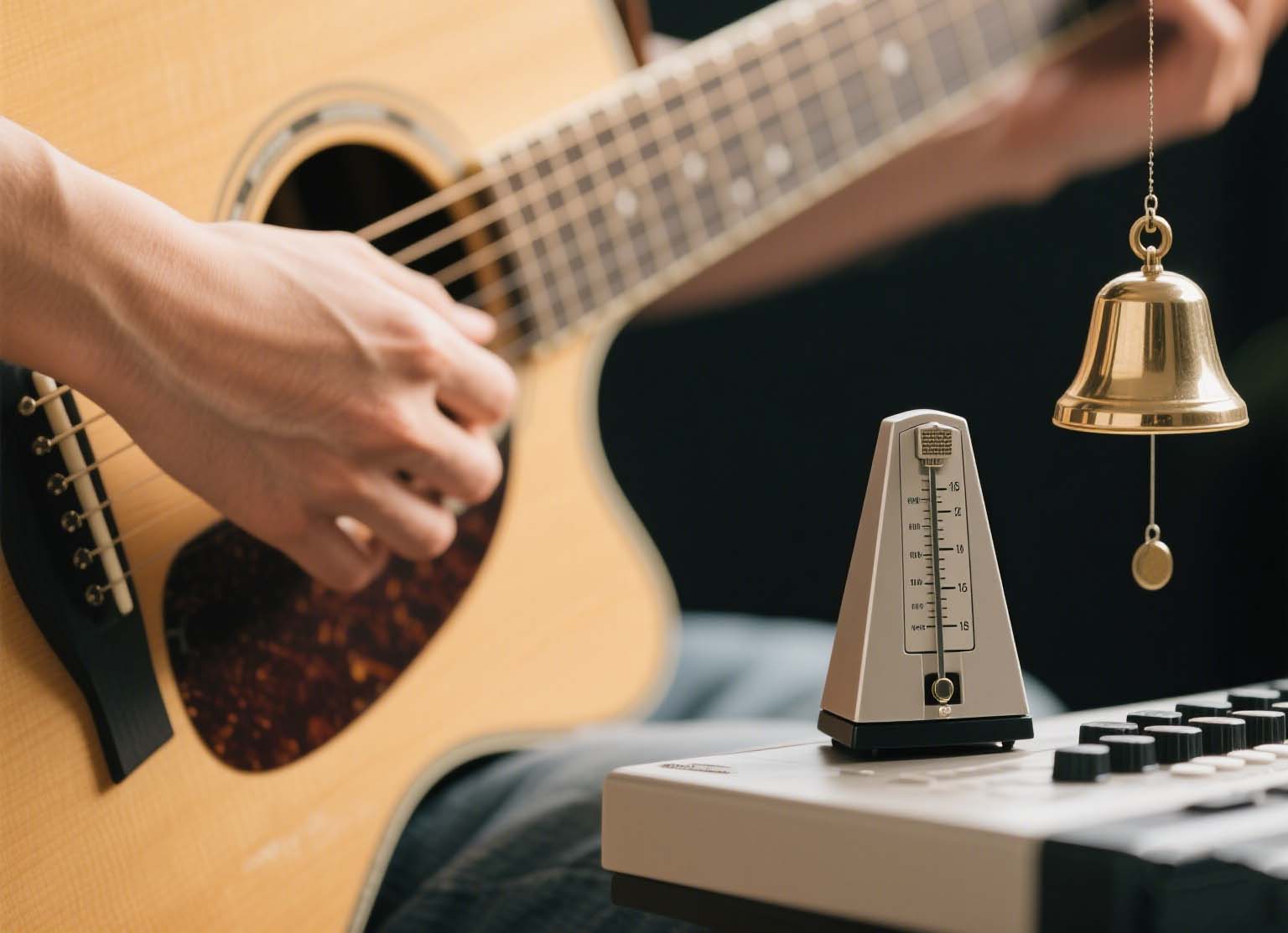I. Understanding Rhythmic Displacement
1. The Cognitive Framework
Rhythmic displacement involves shifting the metronome from its traditional role marking strong beats to instead mark weak beats or offbeats. This practice challenges and strengthens your internal pulse by forcing your brain to infer the underlying beat rather than relying on direct reinforcement. Neurologically, this engages both hemispheres of the brain: the analytical left hemisphere (which processes sequential timing) and the intuitive right hemisphere (which processes overall rhythmic patterns).
2. Musical Applications and Context
Displacement techniques appear across diverse musical contexts: jazz improvisation (where players like Elvin Jones and Tony Williams mastered implying the pulse while playing around it), Afro-Cuban traditions (where the clave pattern serves as a displaced reference point), and contemporary classical music (where composers like Steve Reich use phasing techniques to create rhythmic tension). Understanding these applications provides context for your practice approach.
II. Basic Displacement Exercises in 4/4
1. The Backbeat Shift
Begin with the most accessible displacement in 4/4 time. Set your metronome to a moderate tempo (70-80 BPM) and follow this progression:
- Start with the metronome marking beats 1 and 3 (the strong beats) while you count "1-2-3-4" repeatedly.
- Shift the metronome to mark beats 2 and 4 (the backbeats) while continuing to count all four beats.
- Practice simple rhythmic patterns or scales while maintaining your awareness of the complete measure, with the metronome only reinforcing the backbeats.
- Gradually increase the tempo as your comfort level improves.
2. The Offbeat Challenge
For a more advanced displacement, practice with the metronome marking the "and" counts:
- Set your metronome to a moderate tempo and count "1-&-2-&-3-&-4-&" with the metronome initially marking all eight subdivisions.
- Adjust the metronome to mark only the "&" counts (the offbeats between the main beats).
- Practice playing or clapping on the main beats (1-2-3-4) while the metronome reinforces only the offbeats.
- Once comfortable, try playing more complex rhythms while maintaining your orientation to the implied main beats.
III. Advanced Displacement Strategies
1. The Partial Measure Method
This technique involves placing the metronome on specific, isolated beats within the measure:
- In 4/4 time, set your metronome to a moderate tempo (60-72 BPM).
- Configure the metronome to sound only on beat 3 of each measure.
- Practice playing while mentally filling in beats 1, 2, and 4.
- Systematically work through all possible single-beat placements (only beat 1, only beat 2, etc.).
- Progress to more complex patterns: beats 1 and 3, beats 2 and 4, beats 1 and 4, etc.
2. The Metric Modulation Displacement
This advanced technique combines displacement with metric modulation:
- Begin with your metronome marking quarter notes in 4/4 time at a moderate tempo.
- Mentally reinterpret the metronome clicks as marking triplet quarter notes.
- This creates a 3:4 relationship where the metronome gradually shifts position relative to your 4/4 count.
- Practice maintaining a steady 4/4 pulse while the metronome cycles through different positions in the measure.
- Note that the pattern will realign every 3 measures (or 12 beats).
IV. Instrument-Specific Applications
1. Rhythm Section Instruments
For drummers, bassists, and rhythm guitarists:
- Practice groove displacement by maintaining a steady pattern while the metronome marks unusual beats (e.g., only the "4" of each measure).
- Work on syncopation exercises where you play primarily on offbeats while the metronome marks main beats.
- Develop the ability to switch between playing with and against the displaced metronome within a single performance.
- For drummers specifically: practice independence exercises where different limbs relate differently to the displaced metronome.
2. Melodic Instruments
For melodic instrumentalists:
- Practice scales and arpeggios with the metronome marking only specific beats (e.g., only beat 2 of each measure).
- Work on phrase displacement by starting melodic phrases on different beats relative to the metronome's position.
- Develop the ability to maintain consistent eighth-note or sixteenth-note lines while the metronome marks unusual reference points.
- Practice sight-reading with a displaced metronome to strengthen your ability to maintain tempo independently.
V. Improvisational and Compositional Applications
1. Creating Rhythmic Tension and Release
In improvisation and composition:
- Use displacement to create and resolve rhythmic tension by playing "around" the beat before returning to alignment with it.
- Practice metric superimposition by implying a different meter against the established pulse (e.g., implying 3/4 over 4/4).
- Experiment with rhythmic illusions where the perceived downbeat shifts due to accent patterns.
- Develop vocabulary for transitioning between displaced and aligned playing.
2. Ensemble Applications
When working with other musicians:
- Practice having different ensemble members relate to different reference points (e.g., bass player locks with beat 1, while drummer emphasizes beats 2 and 4).
- Develop cue systems for navigating sections with intentional metric displacement.
- Experiment with one section of the ensemble playing displaced while another maintains the primary pulse.
- Create arrangements that exploit the tension between displaced and aligned rhythmic elements.
VI. Progressive Practice Methodology
1. The 5-Stage Displacement Mastery System
Follow this structured approach to developing displacement proficiency:
- Awareness Stage: Practice with the metronome marking all beats while consciously noting the relationship between strong and weak beats.
- Basic Displacement Stage: Work with the metronome on beats 2 and 4 only, developing comfort with this fundamental displacement.
- Subdivision Displacement Stage: Progress to the metronome marking offbeats or specific subdivisions.
- Random Displacement Stage: Use apps like Time Guru that can randomly mute certain metronome beats, forcing you to maintain the pulse through silent beats.
- Creative Application Stage: Intentionally incorporate displacement techniques into your improvisation and composition.
2. Troubleshooting Common Challenges
When practicing displacement exercises:
- If you consistently lose the pulse, return to a simpler displacement or slower tempo.
- Record your practice sessions to objectively assess your ability to maintain tempo despite displacement.
- Use physical movement (foot tapping, head nodding) to reinforce your internal pulse.
- Practice in short, focused sessions (10-15 minutes) rather than extended periods to prevent mental fatigue.
Note: Begin displacement practice at comfortable tempos (60-80 BPM) and increase speed only after achieving consistency. Apps like Metronomics or Polynome offer advanced features for creating custom displacement patterns.






